Analyzing Supply Chain and Logistics in a Business Context - Unit 46
VerifiedAdded on 2022/11/25
|13
|3155
|251
Report
AI Summary
This report provides a comprehensive analysis of supply chain and logistics, examining the global scope of supply chain networks and their role in achieving customer satisfaction. It illustrates product flow through a biscuit production process and identifies different job roles within a logistics company. The report defines the concept of adding value in the supply chain, using examples like P&G and Dell, and explores the effects of adding value on job roles. It explains the relationship between information flow and logistics functions, highlighting the importance of technology such as shipment tracking and RFID. The report evaluates the impact of information technology on firm operations and examines the effects of quality on supply chain operations, particularly in the Jebel Ali Free Zone, considering aspects of customer service. It also explains how good quality logistics operations can impact customer service. The report incorporates diagrams and references to support its findings, providing a thorough overview of supply chain management principles and practices.
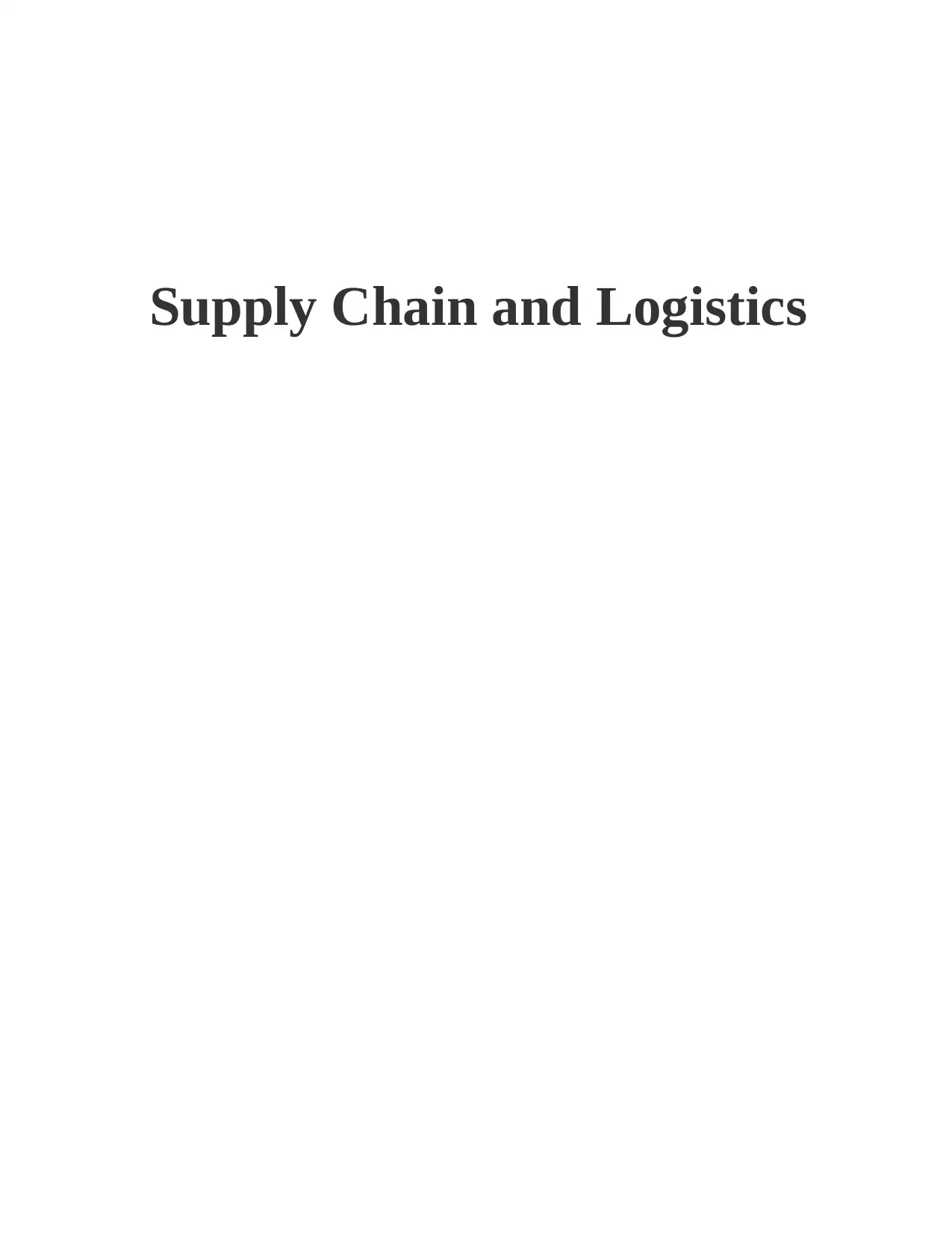
Supply Chain and Logistics
Paraphrase This Document
Need a fresh take? Get an instant paraphrase of this document with our AI Paraphraser
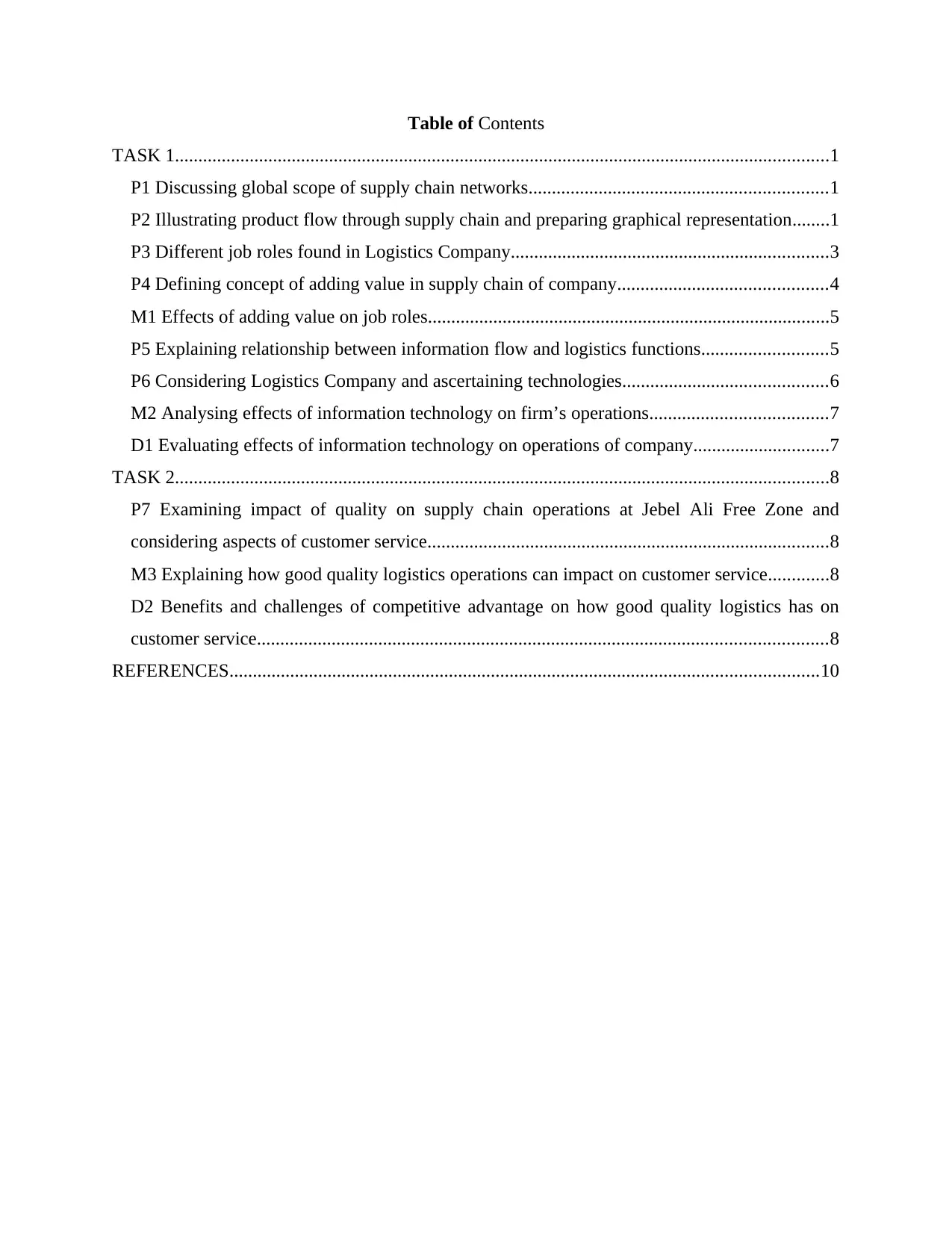
Table of Contents
TASK 1............................................................................................................................................1
P1 Discussing global scope of supply chain networks................................................................1
P2 Illustrating product flow through supply chain and preparing graphical representation........1
P3 Different job roles found in Logistics Company....................................................................3
P4 Defining concept of adding value in supply chain of company.............................................4
M1 Effects of adding value on job roles......................................................................................5
P5 Explaining relationship between information flow and logistics functions...........................5
P6 Considering Logistics Company and ascertaining technologies............................................6
M2 Analysing effects of information technology on firm’s operations......................................7
D1 Evaluating effects of information technology on operations of company.............................7
TASK 2............................................................................................................................................8
P7 Examining impact of quality on supply chain operations at Jebel Ali Free Zone and
considering aspects of customer service......................................................................................8
M3 Explaining how good quality logistics operations can impact on customer service.............8
D2 Benefits and challenges of competitive advantage on how good quality logistics has on
customer service..........................................................................................................................8
REFERENCES..............................................................................................................................10
TASK 1............................................................................................................................................1
P1 Discussing global scope of supply chain networks................................................................1
P2 Illustrating product flow through supply chain and preparing graphical representation........1
P3 Different job roles found in Logistics Company....................................................................3
P4 Defining concept of adding value in supply chain of company.............................................4
M1 Effects of adding value on job roles......................................................................................5
P5 Explaining relationship between information flow and logistics functions...........................5
P6 Considering Logistics Company and ascertaining technologies............................................6
M2 Analysing effects of information technology on firm’s operations......................................7
D1 Evaluating effects of information technology on operations of company.............................7
TASK 2............................................................................................................................................8
P7 Examining impact of quality on supply chain operations at Jebel Ali Free Zone and
considering aspects of customer service......................................................................................8
M3 Explaining how good quality logistics operations can impact on customer service.............8
D2 Benefits and challenges of competitive advantage on how good quality logistics has on
customer service..........................................................................................................................8
REFERENCES..............................................................................................................................10
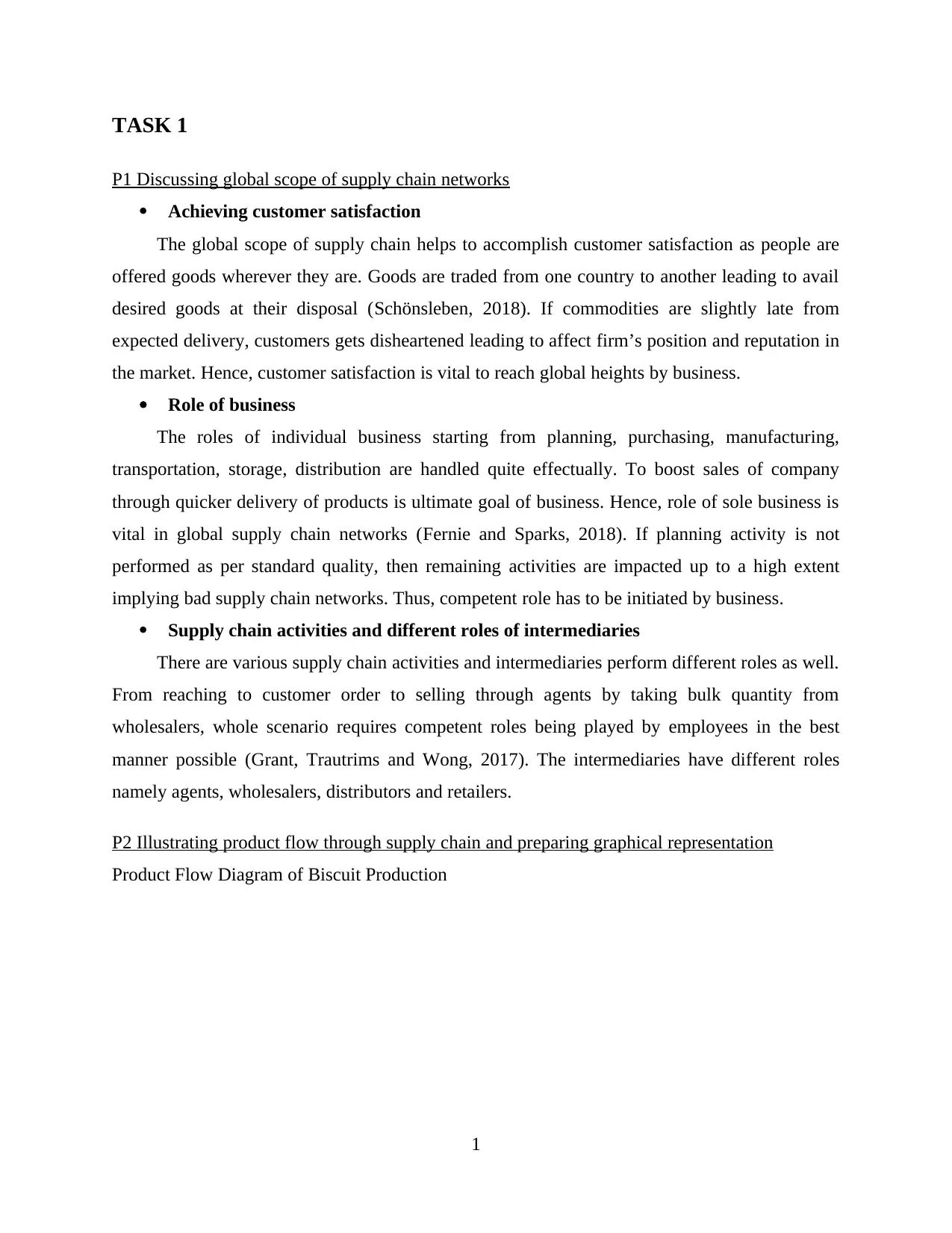
TASK 1
P1 Discussing global scope of supply chain networks
Achieving customer satisfaction
The global scope of supply chain helps to accomplish customer satisfaction as people are
offered goods wherever they are. Goods are traded from one country to another leading to avail
desired goods at their disposal (Schönsleben, 2018). If commodities are slightly late from
expected delivery, customers gets disheartened leading to affect firm’s position and reputation in
the market. Hence, customer satisfaction is vital to reach global heights by business.
Role of business
The roles of individual business starting from planning, purchasing, manufacturing,
transportation, storage, distribution are handled quite effectually. To boost sales of company
through quicker delivery of products is ultimate goal of business. Hence, role of sole business is
vital in global supply chain networks (Fernie and Sparks, 2018). If planning activity is not
performed as per standard quality, then remaining activities are impacted up to a high extent
implying bad supply chain networks. Thus, competent role has to be initiated by business.
Supply chain activities and different roles of intermediaries
There are various supply chain activities and intermediaries perform different roles as well.
From reaching to customer order to selling through agents by taking bulk quantity from
wholesalers, whole scenario requires competent roles being played by employees in the best
manner possible (Grant, Trautrims and Wong, 2017). The intermediaries have different roles
namely agents, wholesalers, distributors and retailers.
P2 Illustrating product flow through supply chain and preparing graphical representation
Product Flow Diagram of Biscuit Production
1
P1 Discussing global scope of supply chain networks
Achieving customer satisfaction
The global scope of supply chain helps to accomplish customer satisfaction as people are
offered goods wherever they are. Goods are traded from one country to another leading to avail
desired goods at their disposal (Schönsleben, 2018). If commodities are slightly late from
expected delivery, customers gets disheartened leading to affect firm’s position and reputation in
the market. Hence, customer satisfaction is vital to reach global heights by business.
Role of business
The roles of individual business starting from planning, purchasing, manufacturing,
transportation, storage, distribution are handled quite effectually. To boost sales of company
through quicker delivery of products is ultimate goal of business. Hence, role of sole business is
vital in global supply chain networks (Fernie and Sparks, 2018). If planning activity is not
performed as per standard quality, then remaining activities are impacted up to a high extent
implying bad supply chain networks. Thus, competent role has to be initiated by business.
Supply chain activities and different roles of intermediaries
There are various supply chain activities and intermediaries perform different roles as well.
From reaching to customer order to selling through agents by taking bulk quantity from
wholesalers, whole scenario requires competent roles being played by employees in the best
manner possible (Grant, Trautrims and Wong, 2017). The intermediaries have different roles
namely agents, wholesalers, distributors and retailers.
P2 Illustrating product flow through supply chain and preparing graphical representation
Product Flow Diagram of Biscuit Production
1
⊘ This is a preview!⊘
Do you want full access?
Subscribe today to unlock all pages.

Trusted by 1+ million students worldwide
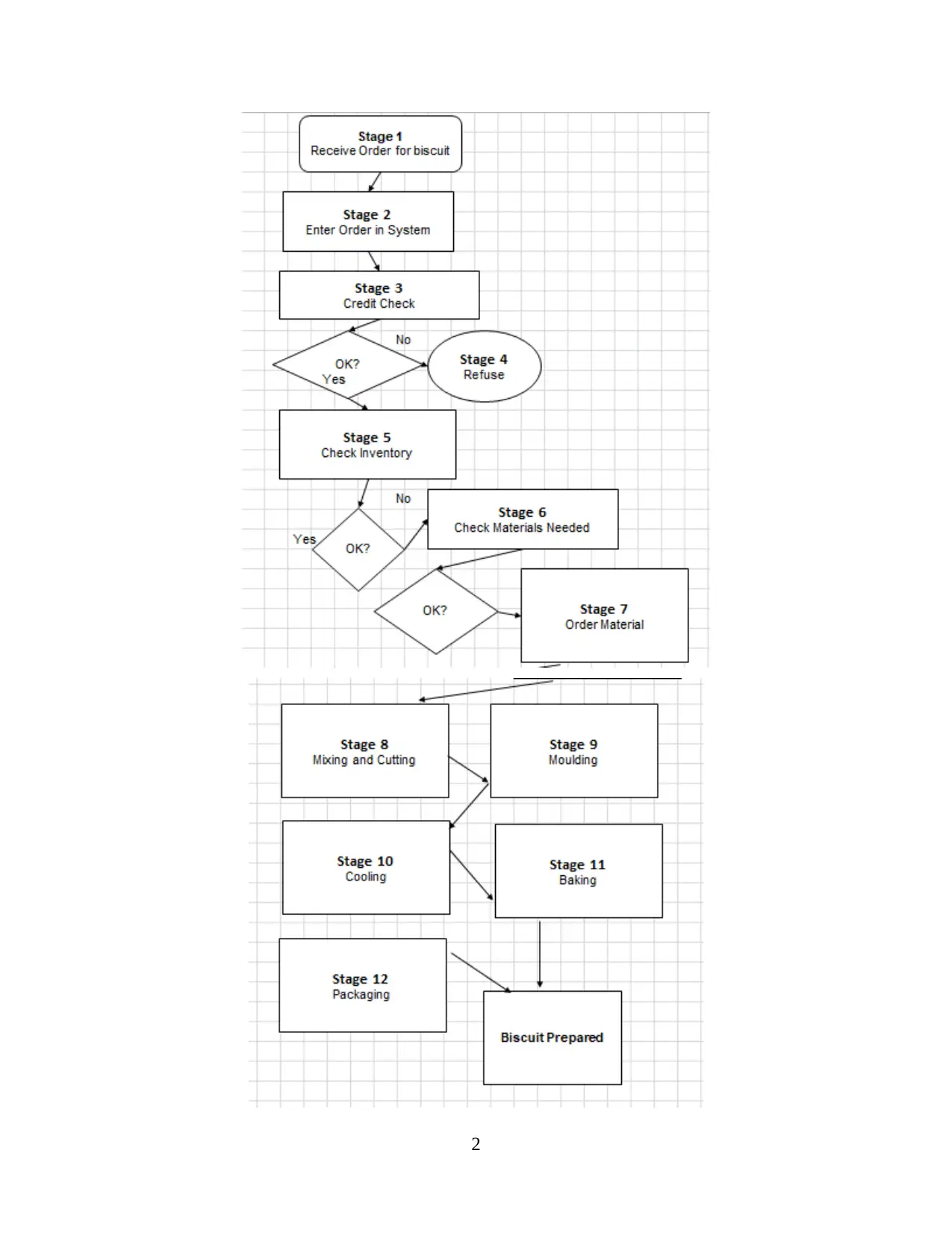
2
Paraphrase This Document
Need a fresh take? Get an instant paraphrase of this document with our AI Paraphraser
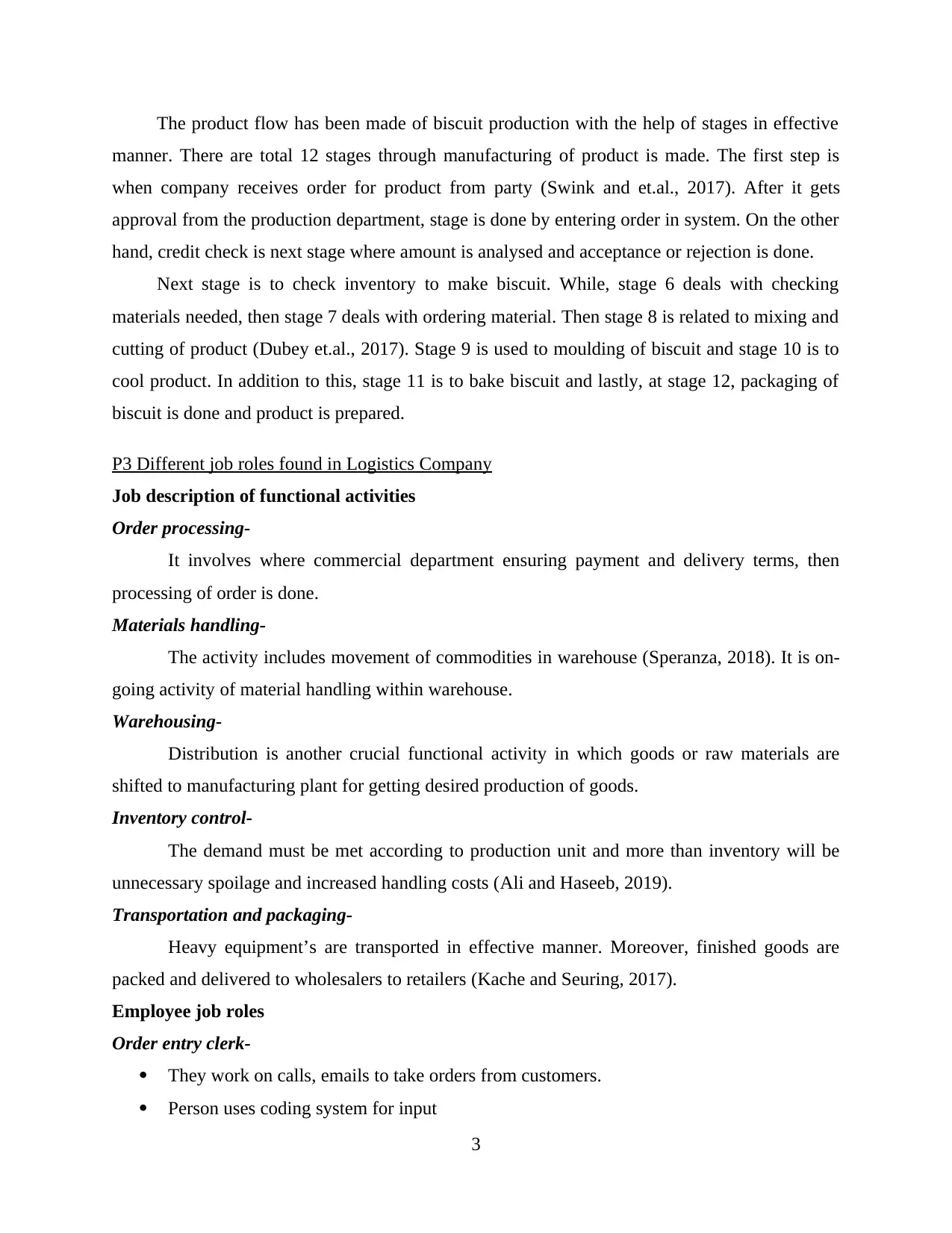
The product flow has been made of biscuit production with the help of stages in effective
manner. There are total 12 stages through manufacturing of product is made. The first step is
when company receives order for product from party (Swink and et.al., 2017). After it gets
approval from the production department, stage is done by entering order in system. On the other
hand, credit check is next stage where amount is analysed and acceptance or rejection is done.
Next stage is to check inventory to make biscuit. While, stage 6 deals with checking
materials needed, then stage 7 deals with ordering material. Then stage 8 is related to mixing and
cutting of product (Dubey et.al., 2017). Stage 9 is used to moulding of biscuit and stage 10 is to
cool product. In addition to this, stage 11 is to bake biscuit and lastly, at stage 12, packaging of
biscuit is done and product is prepared.
P3 Different job roles found in Logistics Company
Job description of functional activities
Order processing-
It involves where commercial department ensuring payment and delivery terms, then
processing of order is done.
Materials handling-
The activity includes movement of commodities in warehouse (Speranza, 2018). It is on-
going activity of material handling within warehouse.
Warehousing-
Distribution is another crucial functional activity in which goods or raw materials are
shifted to manufacturing plant for getting desired production of goods.
Inventory control-
The demand must be met according to production unit and more than inventory will be
unnecessary spoilage and increased handling costs (Ali and Haseeb, 2019).
Transportation and packaging-
Heavy equipment’s are transported in effective manner. Moreover, finished goods are
packed and delivered to wholesalers to retailers (Kache and Seuring, 2017).
Employee job roles
Order entry clerk-
They work on calls, emails to take orders from customers.
Person uses coding system for input
3
manner. There are total 12 stages through manufacturing of product is made. The first step is
when company receives order for product from party (Swink and et.al., 2017). After it gets
approval from the production department, stage is done by entering order in system. On the other
hand, credit check is next stage where amount is analysed and acceptance or rejection is done.
Next stage is to check inventory to make biscuit. While, stage 6 deals with checking
materials needed, then stage 7 deals with ordering material. Then stage 8 is related to mixing and
cutting of product (Dubey et.al., 2017). Stage 9 is used to moulding of biscuit and stage 10 is to
cool product. In addition to this, stage 11 is to bake biscuit and lastly, at stage 12, packaging of
biscuit is done and product is prepared.
P3 Different job roles found in Logistics Company
Job description of functional activities
Order processing-
It involves where commercial department ensuring payment and delivery terms, then
processing of order is done.
Materials handling-
The activity includes movement of commodities in warehouse (Speranza, 2018). It is on-
going activity of material handling within warehouse.
Warehousing-
Distribution is another crucial functional activity in which goods or raw materials are
shifted to manufacturing plant for getting desired production of goods.
Inventory control-
The demand must be met according to production unit and more than inventory will be
unnecessary spoilage and increased handling costs (Ali and Haseeb, 2019).
Transportation and packaging-
Heavy equipment’s are transported in effective manner. Moreover, finished goods are
packed and delivered to wholesalers to retailers (Kache and Seuring, 2017).
Employee job roles
Order entry clerk-
They work on calls, emails to take orders from customers.
Person uses coding system for input
3
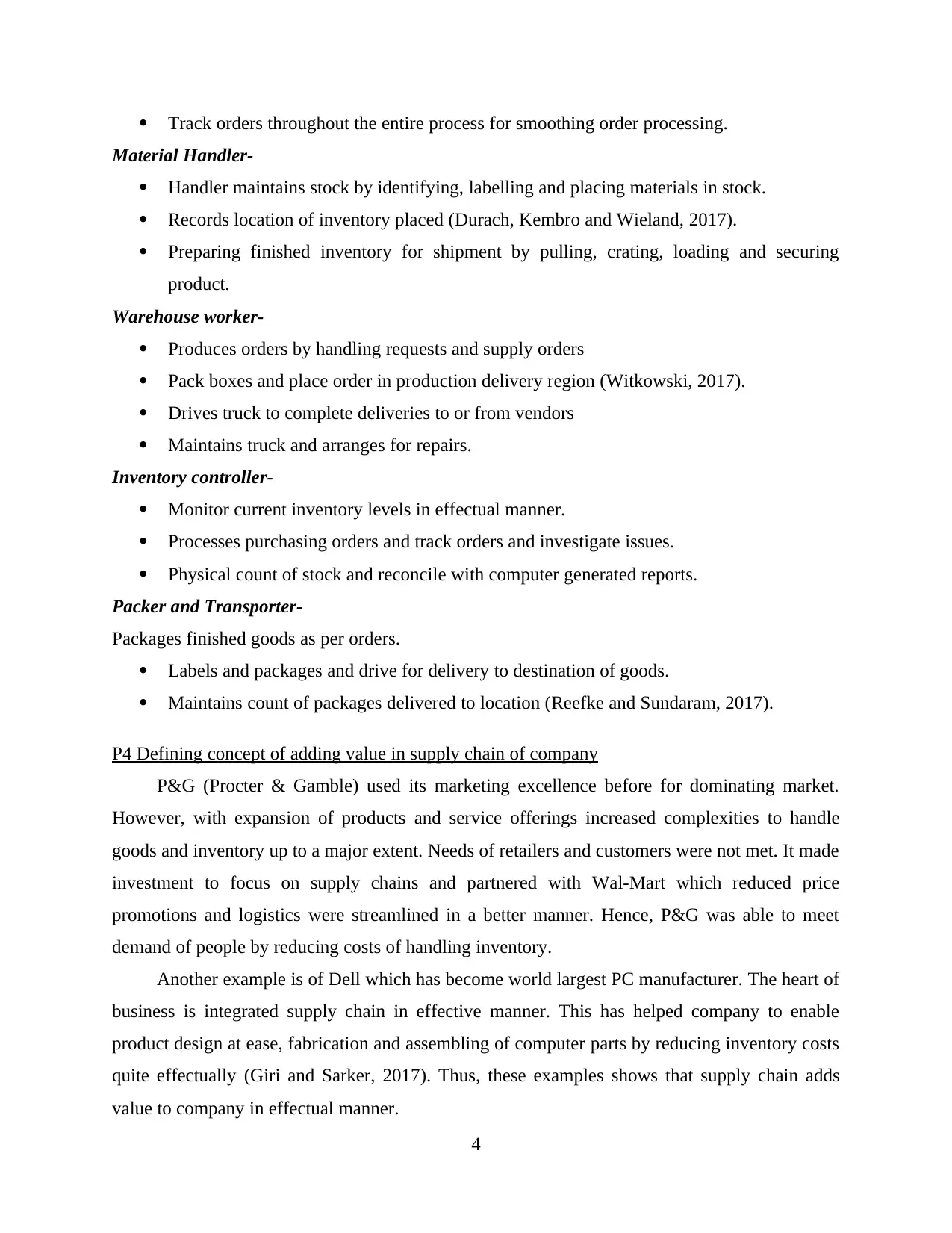
Track orders throughout the entire process for smoothing order processing.
Material Handler-
Handler maintains stock by identifying, labelling and placing materials in stock.
Records location of inventory placed (Durach, Kembro and Wieland, 2017).
Preparing finished inventory for shipment by pulling, crating, loading and securing
product.
Warehouse worker-
Produces orders by handling requests and supply orders
Pack boxes and place order in production delivery region (Witkowski, 2017).
Drives truck to complete deliveries to or from vendors
Maintains truck and arranges for repairs.
Inventory controller-
Monitor current inventory levels in effectual manner.
Processes purchasing orders and track orders and investigate issues.
Physical count of stock and reconcile with computer generated reports.
Packer and Transporter-
Packages finished goods as per orders.
Labels and packages and drive for delivery to destination of goods.
Maintains count of packages delivered to location (Reefke and Sundaram, 2017).
P4 Defining concept of adding value in supply chain of company
P&G (Procter & Gamble) used its marketing excellence before for dominating market.
However, with expansion of products and service offerings increased complexities to handle
goods and inventory up to a major extent. Needs of retailers and customers were not met. It made
investment to focus on supply chains and partnered with Wal-Mart which reduced price
promotions and logistics were streamlined in a better manner. Hence, P&G was able to meet
demand of people by reducing costs of handling inventory.
Another example is of Dell which has become world largest PC manufacturer. The heart of
business is integrated supply chain in effective manner. This has helped company to enable
product design at ease, fabrication and assembling of computer parts by reducing inventory costs
quite effectually (Giri and Sarker, 2017). Thus, these examples shows that supply chain adds
value to company in effectual manner.
4
Material Handler-
Handler maintains stock by identifying, labelling and placing materials in stock.
Records location of inventory placed (Durach, Kembro and Wieland, 2017).
Preparing finished inventory for shipment by pulling, crating, loading and securing
product.
Warehouse worker-
Produces orders by handling requests and supply orders
Pack boxes and place order in production delivery region (Witkowski, 2017).
Drives truck to complete deliveries to or from vendors
Maintains truck and arranges for repairs.
Inventory controller-
Monitor current inventory levels in effectual manner.
Processes purchasing orders and track orders and investigate issues.
Physical count of stock and reconcile with computer generated reports.
Packer and Transporter-
Packages finished goods as per orders.
Labels and packages and drive for delivery to destination of goods.
Maintains count of packages delivered to location (Reefke and Sundaram, 2017).
P4 Defining concept of adding value in supply chain of company
P&G (Procter & Gamble) used its marketing excellence before for dominating market.
However, with expansion of products and service offerings increased complexities to handle
goods and inventory up to a major extent. Needs of retailers and customers were not met. It made
investment to focus on supply chains and partnered with Wal-Mart which reduced price
promotions and logistics were streamlined in a better manner. Hence, P&G was able to meet
demand of people by reducing costs of handling inventory.
Another example is of Dell which has become world largest PC manufacturer. The heart of
business is integrated supply chain in effective manner. This has helped company to enable
product design at ease, fabrication and assembling of computer parts by reducing inventory costs
quite effectually (Giri and Sarker, 2017). Thus, these examples shows that supply chain adds
value to company in effectual manner.
4
⊘ This is a preview!⊘
Do you want full access?
Subscribe today to unlock all pages.

Trusted by 1+ million students worldwide
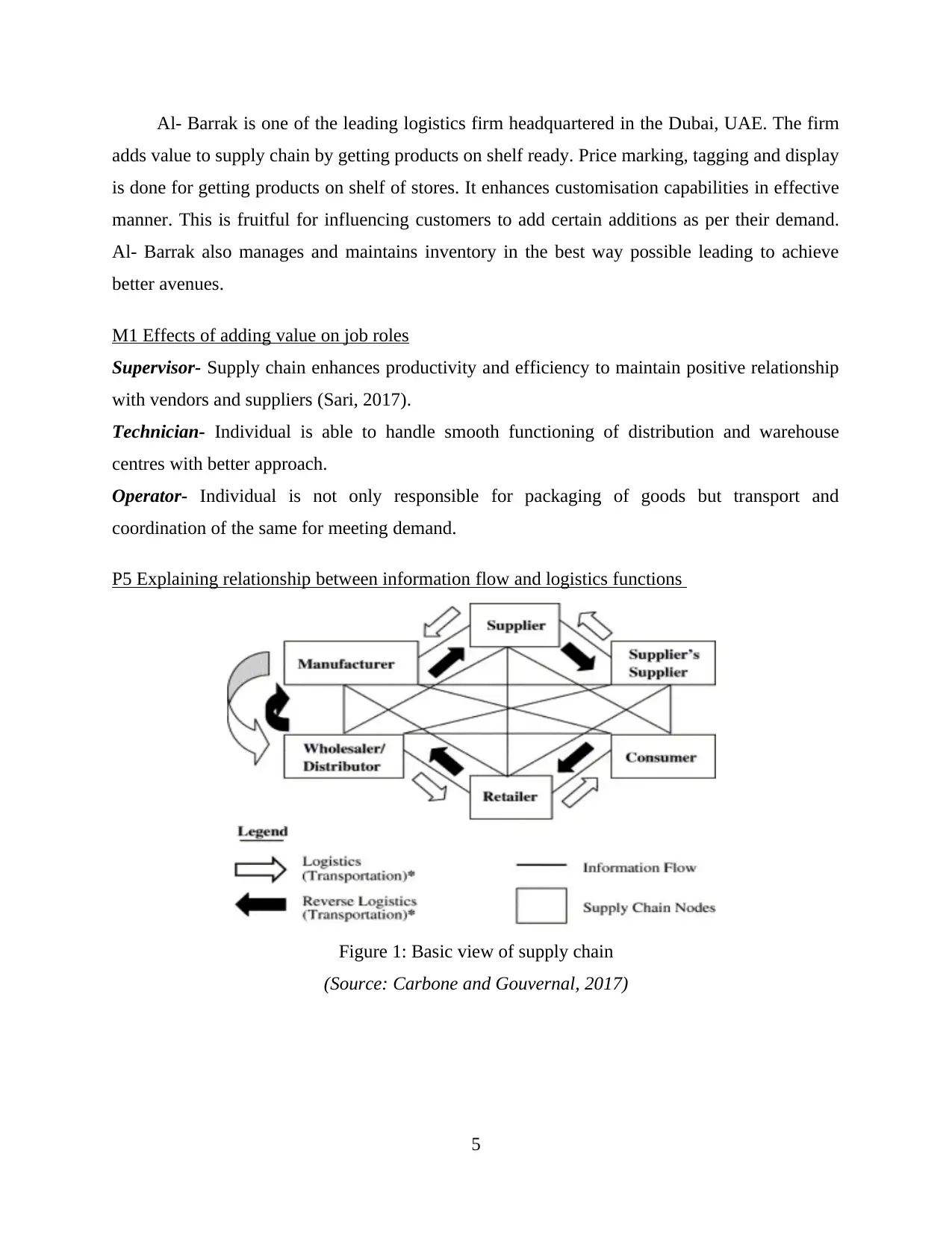
Al- Barrak is one of the leading logistics firm headquartered in the Dubai, UAE. The firm
adds value to supply chain by getting products on shelf ready. Price marking, tagging and display
is done for getting products on shelf of stores. It enhances customisation capabilities in effective
manner. This is fruitful for influencing customers to add certain additions as per their demand.
Al- Barrak also manages and maintains inventory in the best way possible leading to achieve
better avenues.
M1 Effects of adding value on job roles
Supervisor- Supply chain enhances productivity and efficiency to maintain positive relationship
with vendors and suppliers (Sari, 2017).
Technician- Individual is able to handle smooth functioning of distribution and warehouse
centres with better approach.
Operator- Individual is not only responsible for packaging of goods but transport and
coordination of the same for meeting demand.
P5 Explaining relationship between information flow and logistics functions
Figure 1: Basic view of supply chain
(Source: Carbone and Gouvernal, 2017)
5
adds value to supply chain by getting products on shelf ready. Price marking, tagging and display
is done for getting products on shelf of stores. It enhances customisation capabilities in effective
manner. This is fruitful for influencing customers to add certain additions as per their demand.
Al- Barrak also manages and maintains inventory in the best way possible leading to achieve
better avenues.
M1 Effects of adding value on job roles
Supervisor- Supply chain enhances productivity and efficiency to maintain positive relationship
with vendors and suppliers (Sari, 2017).
Technician- Individual is able to handle smooth functioning of distribution and warehouse
centres with better approach.
Operator- Individual is not only responsible for packaging of goods but transport and
coordination of the same for meeting demand.
P5 Explaining relationship between information flow and logistics functions
Figure 1: Basic view of supply chain
(Source: Carbone and Gouvernal, 2017)
5
Paraphrase This Document
Need a fresh take? Get an instant paraphrase of this document with our AI Paraphraser
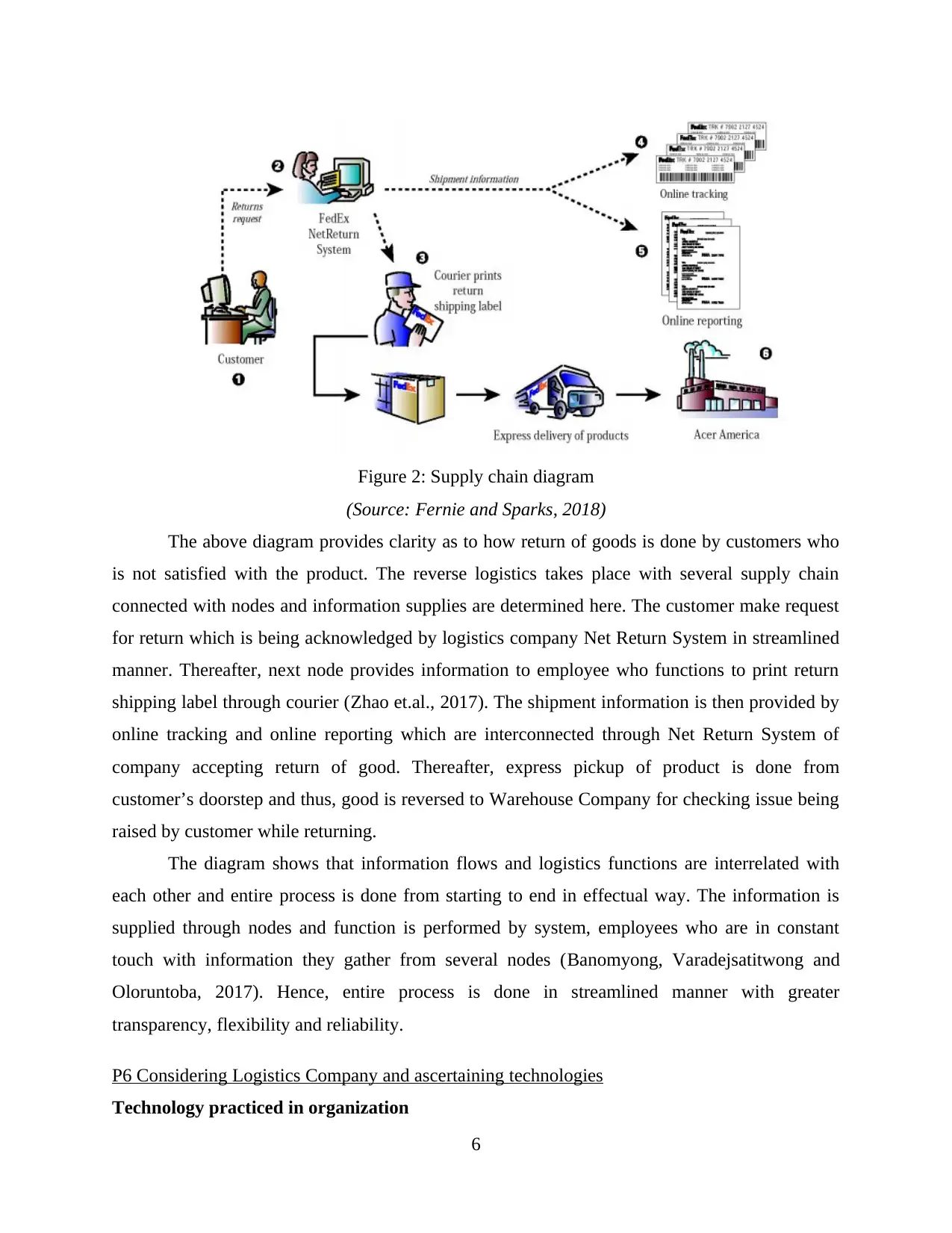
Figure 2: Supply chain diagram
(Source: Fernie and Sparks, 2018)
The above diagram provides clarity as to how return of goods is done by customers who
is not satisfied with the product. The reverse logistics takes place with several supply chain
connected with nodes and information supplies are determined here. The customer make request
for return which is being acknowledged by logistics company Net Return System in streamlined
manner. Thereafter, next node provides information to employee who functions to print return
shipping label through courier (Zhao et.al., 2017). The shipment information is then provided by
online tracking and online reporting which are interconnected through Net Return System of
company accepting return of good. Thereafter, express pickup of product is done from
customer’s doorstep and thus, good is reversed to Warehouse Company for checking issue being
raised by customer while returning.
The diagram shows that information flows and logistics functions are interrelated with
each other and entire process is done from starting to end in effectual way. The information is
supplied through nodes and function is performed by system, employees who are in constant
touch with information they gather from several nodes (Banomyong, Varadejsatitwong and
Oloruntoba, 2017). Hence, entire process is done in streamlined manner with greater
transparency, flexibility and reliability.
P6 Considering Logistics Company and ascertaining technologies
Technology practiced in organization
6
(Source: Fernie and Sparks, 2018)
The above diagram provides clarity as to how return of goods is done by customers who
is not satisfied with the product. The reverse logistics takes place with several supply chain
connected with nodes and information supplies are determined here. The customer make request
for return which is being acknowledged by logistics company Net Return System in streamlined
manner. Thereafter, next node provides information to employee who functions to print return
shipping label through courier (Zhao et.al., 2017). The shipment information is then provided by
online tracking and online reporting which are interconnected through Net Return System of
company accepting return of good. Thereafter, express pickup of product is done from
customer’s doorstep and thus, good is reversed to Warehouse Company for checking issue being
raised by customer while returning.
The diagram shows that information flows and logistics functions are interrelated with
each other and entire process is done from starting to end in effectual way. The information is
supplied through nodes and function is performed by system, employees who are in constant
touch with information they gather from several nodes (Banomyong, Varadejsatitwong and
Oloruntoba, 2017). Hence, entire process is done in streamlined manner with greater
transparency, flexibility and reliability.
P6 Considering Logistics Company and ascertaining technologies
Technology practiced in organization
6
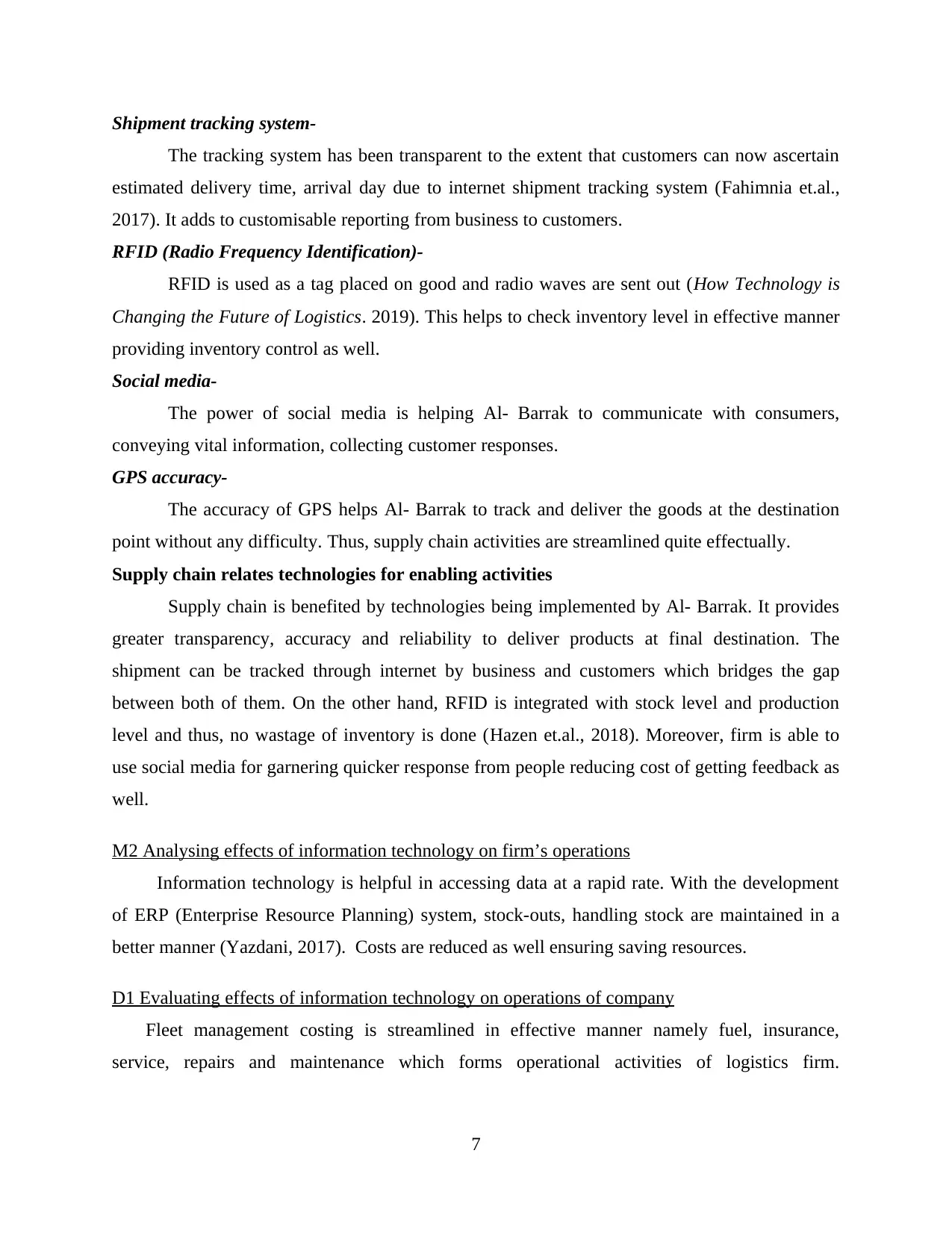
Shipment tracking system-
The tracking system has been transparent to the extent that customers can now ascertain
estimated delivery time, arrival day due to internet shipment tracking system (Fahimnia et.al.,
2017). It adds to customisable reporting from business to customers.
RFID (Radio Frequency Identification)-
RFID is used as a tag placed on good and radio waves are sent out (How Technology is
Changing the Future of Logistics. 2019). This helps to check inventory level in effective manner
providing inventory control as well.
Social media-
The power of social media is helping Al- Barrak to communicate with consumers,
conveying vital information, collecting customer responses.
GPS accuracy-
The accuracy of GPS helps Al- Barrak to track and deliver the goods at the destination
point without any difficulty. Thus, supply chain activities are streamlined quite effectually.
Supply chain relates technologies for enabling activities
Supply chain is benefited by technologies being implemented by Al- Barrak. It provides
greater transparency, accuracy and reliability to deliver products at final destination. The
shipment can be tracked through internet by business and customers which bridges the gap
between both of them. On the other hand, RFID is integrated with stock level and production
level and thus, no wastage of inventory is done (Hazen et.al., 2018). Moreover, firm is able to
use social media for garnering quicker response from people reducing cost of getting feedback as
well.
M2 Analysing effects of information technology on firm’s operations
Information technology is helpful in accessing data at a rapid rate. With the development
of ERP (Enterprise Resource Planning) system, stock-outs, handling stock are maintained in a
better manner (Yazdani, 2017). Costs are reduced as well ensuring saving resources.
D1 Evaluating effects of information technology on operations of company
Fleet management costing is streamlined in effective manner namely fuel, insurance,
service, repairs and maintenance which forms operational activities of logistics firm.
7
The tracking system has been transparent to the extent that customers can now ascertain
estimated delivery time, arrival day due to internet shipment tracking system (Fahimnia et.al.,
2017). It adds to customisable reporting from business to customers.
RFID (Radio Frequency Identification)-
RFID is used as a tag placed on good and radio waves are sent out (How Technology is
Changing the Future of Logistics. 2019). This helps to check inventory level in effective manner
providing inventory control as well.
Social media-
The power of social media is helping Al- Barrak to communicate with consumers,
conveying vital information, collecting customer responses.
GPS accuracy-
The accuracy of GPS helps Al- Barrak to track and deliver the goods at the destination
point without any difficulty. Thus, supply chain activities are streamlined quite effectually.
Supply chain relates technologies for enabling activities
Supply chain is benefited by technologies being implemented by Al- Barrak. It provides
greater transparency, accuracy and reliability to deliver products at final destination. The
shipment can be tracked through internet by business and customers which bridges the gap
between both of them. On the other hand, RFID is integrated with stock level and production
level and thus, no wastage of inventory is done (Hazen et.al., 2018). Moreover, firm is able to
use social media for garnering quicker response from people reducing cost of getting feedback as
well.
M2 Analysing effects of information technology on firm’s operations
Information technology is helpful in accessing data at a rapid rate. With the development
of ERP (Enterprise Resource Planning) system, stock-outs, handling stock are maintained in a
better manner (Yazdani, 2017). Costs are reduced as well ensuring saving resources.
D1 Evaluating effects of information technology on operations of company
Fleet management costing is streamlined in effective manner namely fuel, insurance,
service, repairs and maintenance which forms operational activities of logistics firm.
7
⊘ This is a preview!⊘
Do you want full access?
Subscribe today to unlock all pages.

Trusted by 1+ million students worldwide
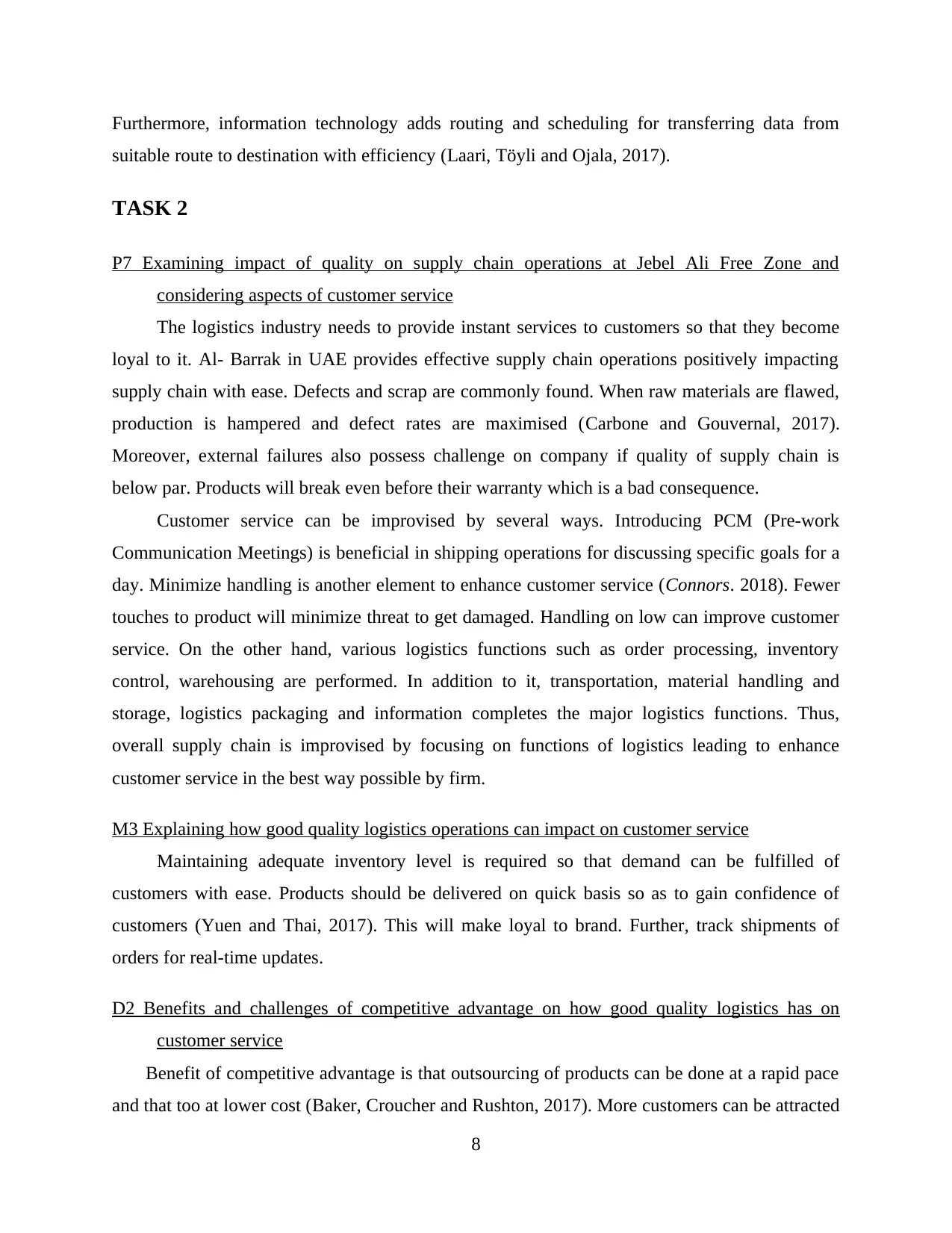
Furthermore, information technology adds routing and scheduling for transferring data from
suitable route to destination with efficiency (Laari, Töyli and Ojala, 2017).
TASK 2
P7 Examining impact of quality on supply chain operations at Jebel Ali Free Zone and
considering aspects of customer service
The logistics industry needs to provide instant services to customers so that they become
loyal to it. Al- Barrak in UAE provides effective supply chain operations positively impacting
supply chain with ease. Defects and scrap are commonly found. When raw materials are flawed,
production is hampered and defect rates are maximised (Carbone and Gouvernal, 2017).
Moreover, external failures also possess challenge on company if quality of supply chain is
below par. Products will break even before their warranty which is a bad consequence.
Customer service can be improvised by several ways. Introducing PCM (Pre-work
Communication Meetings) is beneficial in shipping operations for discussing specific goals for a
day. Minimize handling is another element to enhance customer service (Connors. 2018). Fewer
touches to product will minimize threat to get damaged. Handling on low can improve customer
service. On the other hand, various logistics functions such as order processing, inventory
control, warehousing are performed. In addition to it, transportation, material handling and
storage, logistics packaging and information completes the major logistics functions. Thus,
overall supply chain is improvised by focusing on functions of logistics leading to enhance
customer service in the best way possible by firm.
M3 Explaining how good quality logistics operations can impact on customer service
Maintaining adequate inventory level is required so that demand can be fulfilled of
customers with ease. Products should be delivered on quick basis so as to gain confidence of
customers (Yuen and Thai, 2017). This will make loyal to brand. Further, track shipments of
orders for real-time updates.
D2 Benefits and challenges of competitive advantage on how good quality logistics has on
customer service
Benefit of competitive advantage is that outsourcing of products can be done at a rapid pace
and that too at lower cost (Baker, Croucher and Rushton, 2017). More customers can be attracted
8
suitable route to destination with efficiency (Laari, Töyli and Ojala, 2017).
TASK 2
P7 Examining impact of quality on supply chain operations at Jebel Ali Free Zone and
considering aspects of customer service
The logistics industry needs to provide instant services to customers so that they become
loyal to it. Al- Barrak in UAE provides effective supply chain operations positively impacting
supply chain with ease. Defects and scrap are commonly found. When raw materials are flawed,
production is hampered and defect rates are maximised (Carbone and Gouvernal, 2017).
Moreover, external failures also possess challenge on company if quality of supply chain is
below par. Products will break even before their warranty which is a bad consequence.
Customer service can be improvised by several ways. Introducing PCM (Pre-work
Communication Meetings) is beneficial in shipping operations for discussing specific goals for a
day. Minimize handling is another element to enhance customer service (Connors. 2018). Fewer
touches to product will minimize threat to get damaged. Handling on low can improve customer
service. On the other hand, various logistics functions such as order processing, inventory
control, warehousing are performed. In addition to it, transportation, material handling and
storage, logistics packaging and information completes the major logistics functions. Thus,
overall supply chain is improvised by focusing on functions of logistics leading to enhance
customer service in the best way possible by firm.
M3 Explaining how good quality logistics operations can impact on customer service
Maintaining adequate inventory level is required so that demand can be fulfilled of
customers with ease. Products should be delivered on quick basis so as to gain confidence of
customers (Yuen and Thai, 2017). This will make loyal to brand. Further, track shipments of
orders for real-time updates.
D2 Benefits and challenges of competitive advantage on how good quality logistics has on
customer service
Benefit of competitive advantage is that outsourcing of products can be done at a rapid pace
and that too at lower cost (Baker, Croucher and Rushton, 2017). More customers can be attracted
8
Paraphrase This Document
Need a fresh take? Get an instant paraphrase of this document with our AI Paraphraser
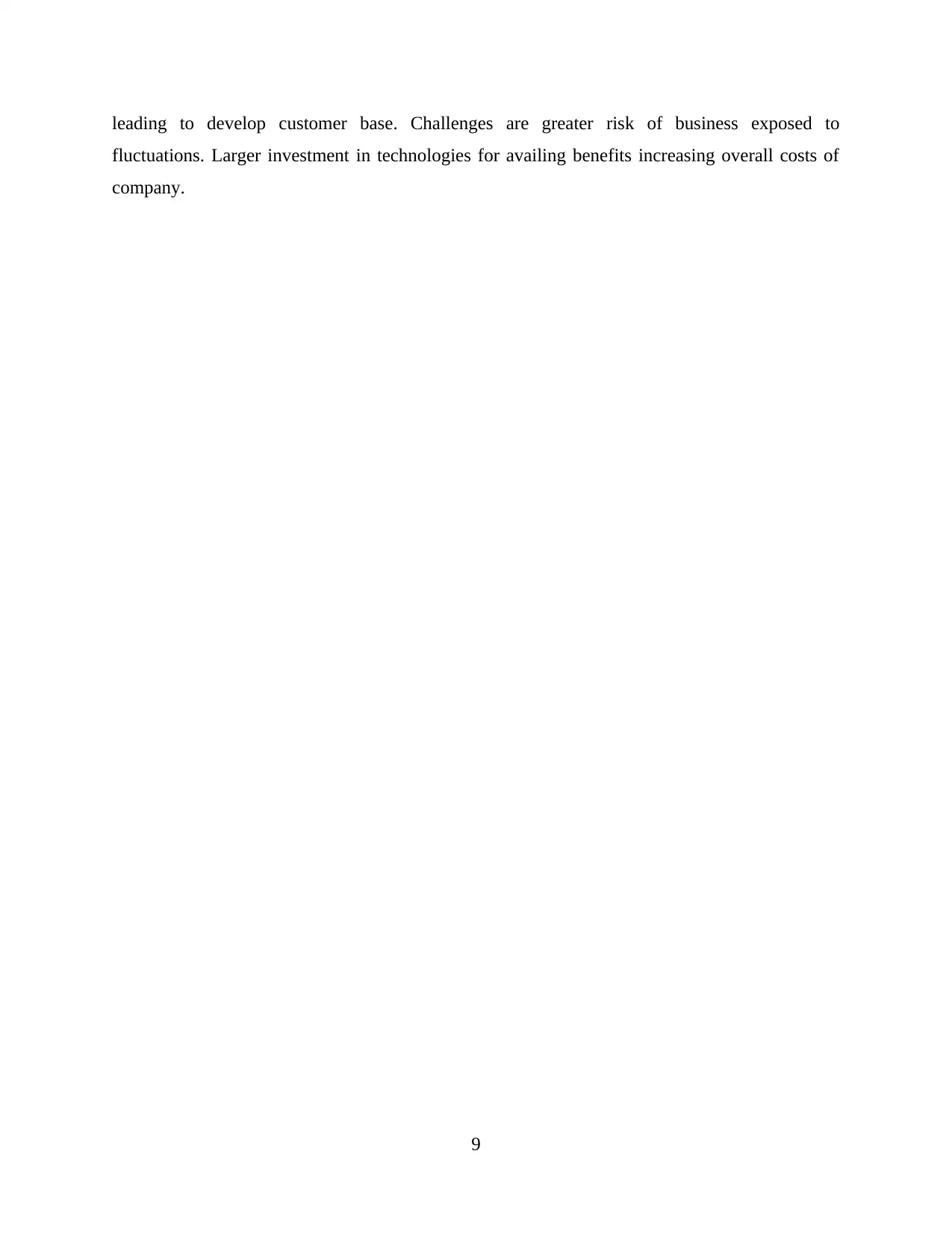
leading to develop customer base. Challenges are greater risk of business exposed to
fluctuations. Larger investment in technologies for availing benefits increasing overall costs of
company.
9
fluctuations. Larger investment in technologies for availing benefits increasing overall costs of
company.
9
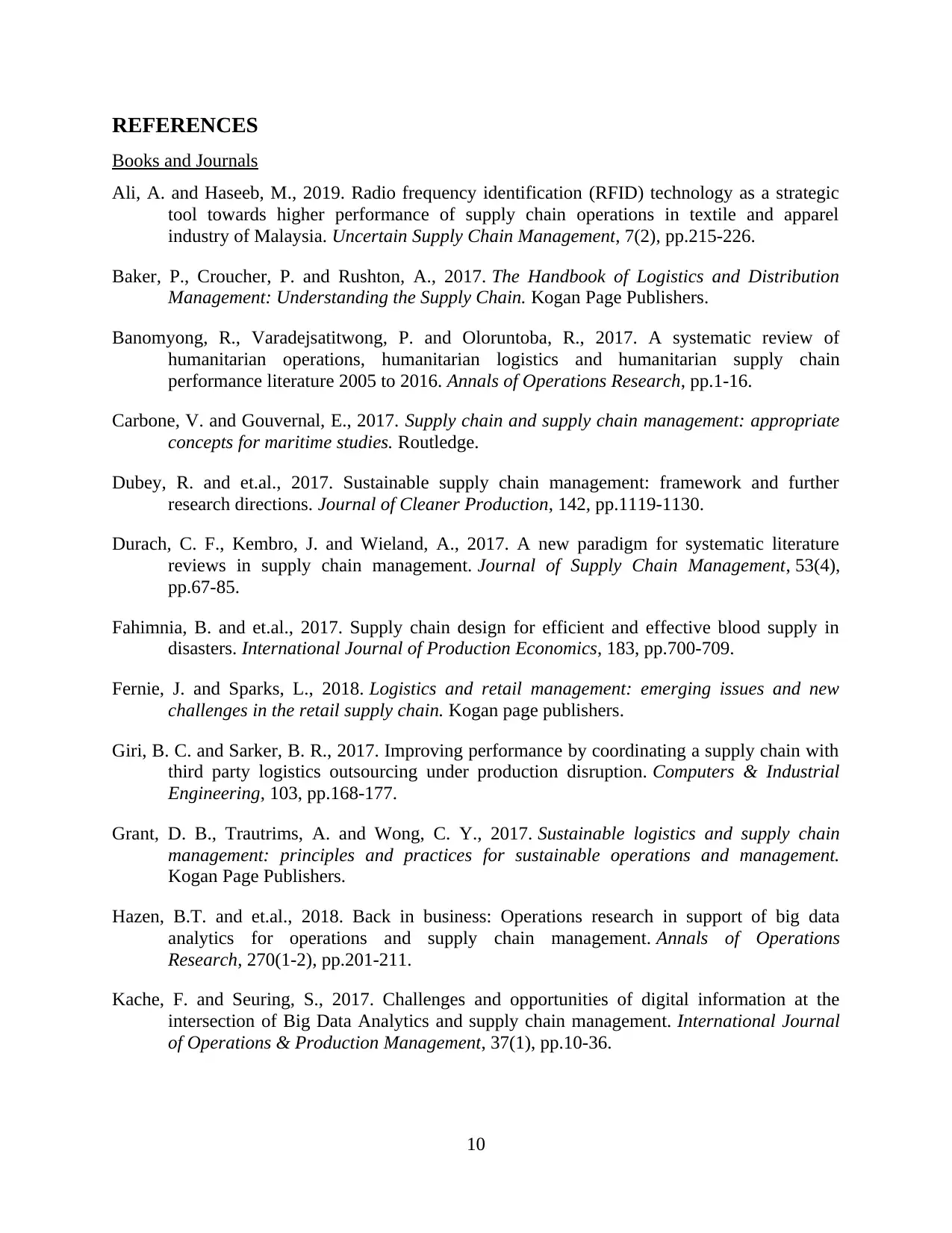
REFERENCES
Books and Journals
Ali, A. and Haseeb, M., 2019. Radio frequency identification (RFID) technology as a strategic
tool towards higher performance of supply chain operations in textile and apparel
industry of Malaysia. Uncertain Supply Chain Management, 7(2), pp.215-226.
Baker, P., Croucher, P. and Rushton, A., 2017. The Handbook of Logistics and Distribution
Management: Understanding the Supply Chain. Kogan Page Publishers.
Banomyong, R., Varadejsatitwong, P. and Oloruntoba, R., 2017. A systematic review of
humanitarian operations, humanitarian logistics and humanitarian supply chain
performance literature 2005 to 2016. Annals of Operations Research, pp.1-16.
Carbone, V. and Gouvernal, E., 2017. Supply chain and supply chain management: appropriate
concepts for maritime studies. Routledge.
Dubey, R. and et.al., 2017. Sustainable supply chain management: framework and further
research directions. Journal of Cleaner Production, 142, pp.1119-1130.
Durach, C. F., Kembro, J. and Wieland, A., 2017. A new paradigm for systematic literature
reviews in supply chain management. Journal of Supply Chain Management, 53(4),
pp.67-85.
Fahimnia, B. and et.al., 2017. Supply chain design for efficient and effective blood supply in
disasters. International Journal of Production Economics, 183, pp.700-709.
Fernie, J. and Sparks, L., 2018. Logistics and retail management: emerging issues and new
challenges in the retail supply chain. Kogan page publishers.
Giri, B. C. and Sarker, B. R., 2017. Improving performance by coordinating a supply chain with
third party logistics outsourcing under production disruption. Computers & Industrial
Engineering, 103, pp.168-177.
Grant, D. B., Trautrims, A. and Wong, C. Y., 2017. Sustainable logistics and supply chain
management: principles and practices for sustainable operations and management.
Kogan Page Publishers.
Hazen, B.T. and et.al., 2018. Back in business: Operations research in support of big data
analytics for operations and supply chain management. Annals of Operations
Research, 270(1-2), pp.201-211.
Kache, F. and Seuring, S., 2017. Challenges and opportunities of digital information at the
intersection of Big Data Analytics and supply chain management. International Journal
of Operations & Production Management, 37(1), pp.10-36.
10
Books and Journals
Ali, A. and Haseeb, M., 2019. Radio frequency identification (RFID) technology as a strategic
tool towards higher performance of supply chain operations in textile and apparel
industry of Malaysia. Uncertain Supply Chain Management, 7(2), pp.215-226.
Baker, P., Croucher, P. and Rushton, A., 2017. The Handbook of Logistics and Distribution
Management: Understanding the Supply Chain. Kogan Page Publishers.
Banomyong, R., Varadejsatitwong, P. and Oloruntoba, R., 2017. A systematic review of
humanitarian operations, humanitarian logistics and humanitarian supply chain
performance literature 2005 to 2016. Annals of Operations Research, pp.1-16.
Carbone, V. and Gouvernal, E., 2017. Supply chain and supply chain management: appropriate
concepts for maritime studies. Routledge.
Dubey, R. and et.al., 2017. Sustainable supply chain management: framework and further
research directions. Journal of Cleaner Production, 142, pp.1119-1130.
Durach, C. F., Kembro, J. and Wieland, A., 2017. A new paradigm for systematic literature
reviews in supply chain management. Journal of Supply Chain Management, 53(4),
pp.67-85.
Fahimnia, B. and et.al., 2017. Supply chain design for efficient and effective blood supply in
disasters. International Journal of Production Economics, 183, pp.700-709.
Fernie, J. and Sparks, L., 2018. Logistics and retail management: emerging issues and new
challenges in the retail supply chain. Kogan page publishers.
Giri, B. C. and Sarker, B. R., 2017. Improving performance by coordinating a supply chain with
third party logistics outsourcing under production disruption. Computers & Industrial
Engineering, 103, pp.168-177.
Grant, D. B., Trautrims, A. and Wong, C. Y., 2017. Sustainable logistics and supply chain
management: principles and practices for sustainable operations and management.
Kogan Page Publishers.
Hazen, B.T. and et.al., 2018. Back in business: Operations research in support of big data
analytics for operations and supply chain management. Annals of Operations
Research, 270(1-2), pp.201-211.
Kache, F. and Seuring, S., 2017. Challenges and opportunities of digital information at the
intersection of Big Data Analytics and supply chain management. International Journal
of Operations & Production Management, 37(1), pp.10-36.
10
⊘ This is a preview!⊘
Do you want full access?
Subscribe today to unlock all pages.

Trusted by 1+ million students worldwide
1 out of 13
Related Documents
Your All-in-One AI-Powered Toolkit for Academic Success.
+13062052269
info@desklib.com
Available 24*7 on WhatsApp / Email
![[object Object]](/_next/static/media/star-bottom.7253800d.svg)
Unlock your academic potential
Copyright © 2020–2025 A2Z Services. All Rights Reserved. Developed and managed by ZUCOL.





